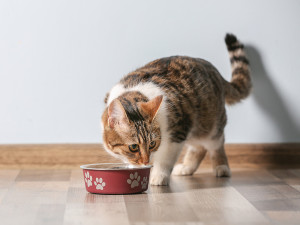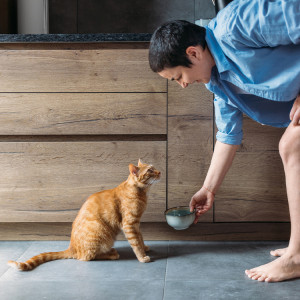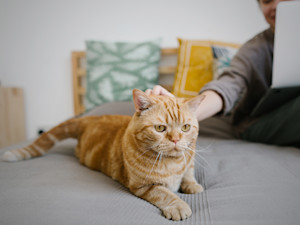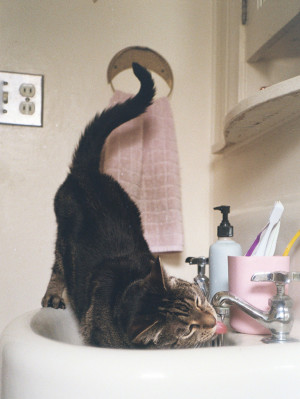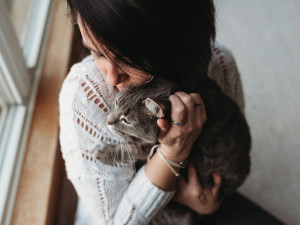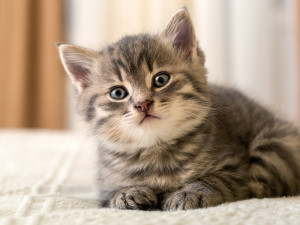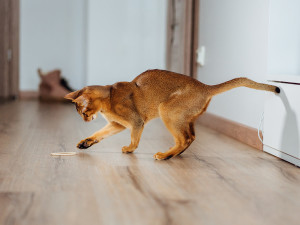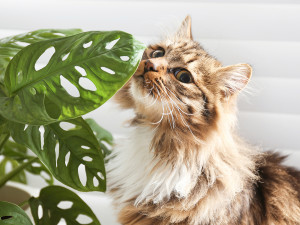Is Your Cat Full of Sh*t?
Seriously, though – here’s how to deal with cat constipation
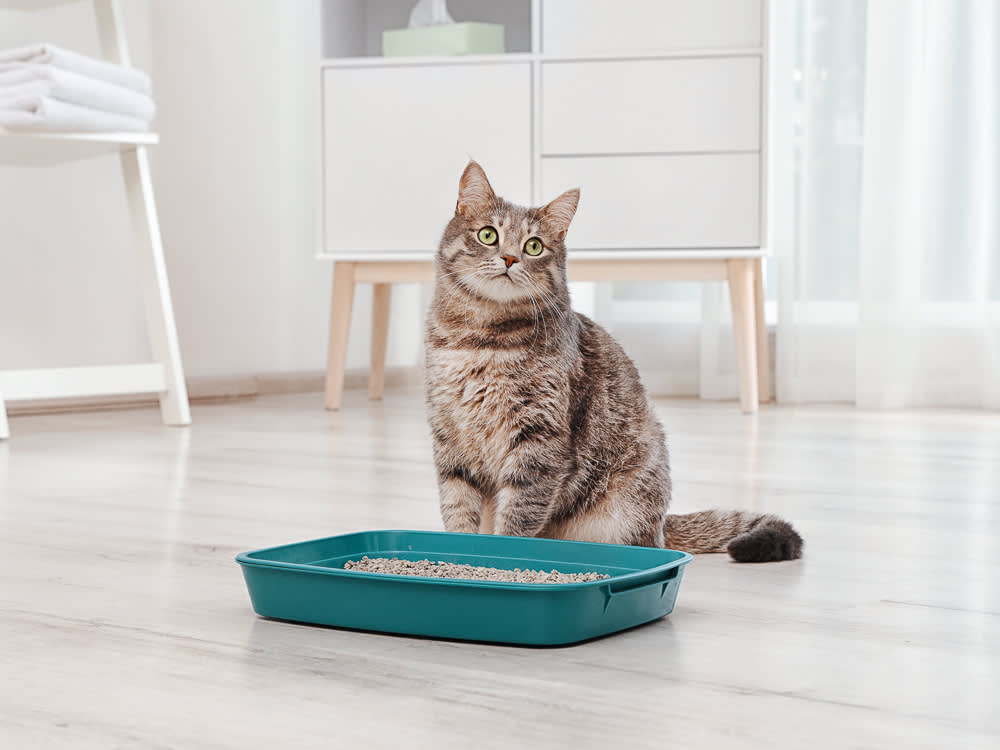
Share Article
Litter box issues can be the bane of kitty existence. As you know, your cat is very... particular. The litter box can be too dirty, too dusty, too inconvenient, or maybe shared with their mortal enemy. There’s a lot that can go wrong in there, which is why it’s a red flag when your cat’s litter box habits change. Worry not – here’s how to help a constipated cat.
Symptoms of cat constipation
A constipated cat has difficulty pooing, hardly ever poos, or stops pooing completely. Common symptoms include posturing and straining inside or outside of the litter box while only producing little or no stool. Vocalisation, vomiting, poor appetite, or abdominal pain can also be seen in constipated cats.
A side note about straining in the litter box – cats can strain in the litter box when they are having difficulty defecating or urinating. If your cat is straining to defecate, they require treatment but can often wait until you schedule an appointment with your veterinarian in the very near future. But if your cat is unable to urinate, they need medical attention urgently. Check the litter box closely to ensure that your cat has urinated recently. If no urine is coming out (especially in male cats), get them to the vet ASAP.
Causes of constipation in cats
Dehydration
Dehydration commonly develops when a cat is not drinking enough water or loses fluid from vomiting. Underlying health issues, such as diabetes mellitus or kidney disease can increase urine production and contribute to fluid loss. When the body doesn’t have enough water, it will try to pull extra water from the colon, leading to dry, hard stool that is difficult to pass.
Orthopaedic pain
Just like dogs and people, cats can develop arthritis as they age. Older cats or cats with a history of a traumatic injury can have hip or lower back pain that makes posturing to defecate uncomfortable. For some cats, simply getting into the litter box presents a challenge. Making an older kitty jump into a high-sided litter box is kind of like asking a little old lady to jump over an Olympic-style hurdle to go to the bathroom.
Litter box anxiety
Cats often steer clear of litter boxes that are dirty, difficult to access, or near people or pets who cause them anxiety. Some cats need peace and quiet during their bathroom trips, so a litter box next to a running washer or dryer may stress them out. Holding on to stool for too long increases the risk of constipation.
Other causes
Tumours or foreign material can cause physical obstructions that hinder the passage of stool. Certain medications or recent anaesthesia can slow GI motility, leading to constipation. Tailless cat breeds, such as Manx cats, are at increased risk for congenital problems with the nerves of the colon. These cats often develop chronic issues with constipation or faecal incontinence.
Treatment for constipated cats
The treatment for constipation depends on the severity. Restoring hydration is an essential first step in treating constipation. Strategies may include feeding canned food to increase water intake, subcutaneous fluid therapy, or hospitalisation for IV fluid therapy.
The next step is getting some of the poop out of your cat. This typically involves an enema or two (or 10) and time to allow your cat to have a bowel movement on their own. While using an over-the-counter enema at home may seem like a good idea, these should be avoided since many are toxic to cats. If enemas don’t work, your veterinarian will manually remove the hard, dry stool to help get things moving. This procedure is called deobstipation. No cat appreciates this process, so it commonly requires sedation or anaesthesia. Don’t try this at home, not that you’d even want to. Your veterinarian may also prescribe a laxative or recommend a psyllium-rich diet to help with colonic motility – anything to keep things moving.
Long-term effects of constipation in cats
A cat who has had an episode of constipation is at increased risk for developing future episodes. A colon that is repeatedly stretched to its max can lose its ability to contract normally. Kitties who experience recurrent bouts of constipation or have their constipation go untreated can become obstipated, which occurs when constipation is so severe that a cat is completely unable to pass stool. Stool continues to accumulate and harden, which leads to megacolon (yes, this is a medical term). Megacolon is irreversible and requires aggressive treatment and sometimes even surgical intervention.
Prevention of cat constipation
Encourage your cat to drink by providing easily accessible fresh water. Kitty drinking fountains can increase water intake in cats who prefer flowing water. Minimise the stress associated with litter box visits by providing clean, easily accessible litter boxes that are comfortable for your cat to use. Ideally, have at least one litter box per cat in the household, located in an area with some privacy.
Encourage your cat to be active, as sedentary cats are more likely to become constipated. Keep longhaired cats well-groomed to prevent constipation from hairballs or matted fur under the tail. Discuss with your vet about switching to a fibre-rich diet or adding a fibre supplement before starting. For some cats with obstipation, extra fibre is not the answer. Discuss chronic pain management with your veterinarian if your cat has arthritis or chronic pain from a previous injury.

Dr. Alycia Washington, DVM, MS
Alycia Washington, DVM, is a small animal emergency veterinarian with over ten years of experience based in North Carolina. She works as a relief veterinarianopens in new tab and provides services to numerous emergency and specialty hospitals. She also works as a veterinary writer with a focus on educating pet owners, and is the author, under the name A. C. Washington, of the children’s book Dr. Jett, Monster Vet.
Related articles
![cat eating sensitive stomach food for cats]()
Do Cat Foods For Sensitive Stomachs Really Help?
Dr Bruce Kornreich explains why going this route isn’t always the answer
![Tabby cat leaning into a porcelain sink, tail curled in the air, as it sticks its tongue out to drink water from the faucet.]()
Why Is My Cat So Damn Thirsty?
No, not like that. They’re literally drinking a lot of water. Here’s when you should be worried
![Woman in a white sweater hugging her cat next to a window]()
Is Your Cat SAD?
Find out if your cat has seasonal depression, and how to combat it
![Kitten sitting on a blanket]()
7 Steps to Keep Your New Kitten Happy and Healthy
A vet breaks down everything you need to know when you bring home a new kitten
![Cat playing and jumping with a rubber band]()
What Should I Know About FIV in Cats?
The most common questions about feline immunodeficiency virus, answered. Good news: most FIV positive cats live long, happy lives
![cat sniffing a plant]()
9 Plants Toxic to Cats
These plants might be beautiful, but they’re deadly to feline foragers

